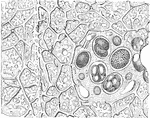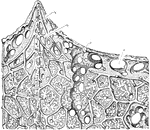Clipart tagged: ‘poriferans’

Lower Section of Sponge
An illustration of the lower portion of a sponge. O, OS, and M are illustrations of sponge eggs magnified…

Upper Section of Sponge
An illustration of the upper portion of a sponge: p, Pore; s, Subdermal cavity; c1, chief fiver of the…